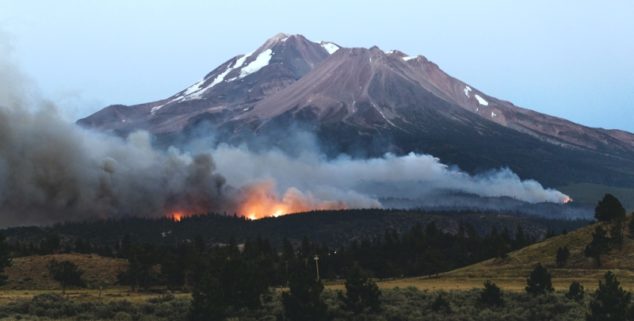News
Fire-ravaged California at ‘pivotal moment’ in its history
 The Lava Fire burns in June on the northwest side of Mt. Shasta. (Photo: Trevor Bexon, via Shutterstock)
The Lava Fire burns in June on the northwest side of Mt. Shasta. (Photo: Trevor Bexon, via Shutterstock)
The statistics are terrifying, the damage heartbreaking and California wildfires continue their rampage.
State officials say the wildfire season in California, once largely relegated to the deep summer, has gradually expanded by more than two months across the Sierra Nevada and now goes well into the fall, compared with earlier years.
Gov. Gavin Newsom on Aug. 10 proclaimed states of emergency in Trinity County, Tehama County and Shasta County.
“We’re at a pivotal moment in California history as we choose how to spend billions of dollars for climate resilience and wildfire preparation in the state budget,” said state Sen. Henry Stern, chair of the Joint Legislative Committee on Emergency Management.
“For the past few years, our wildfire seasons have become more dangerous and destructive because of the effects of climate change,” Stern adcded. “There’s so much risk if we fail to take action, but if we seize the moment, we can save so many lives…”
Gov. Gavin Newsom on Aug. 10 proclaimed a state of emergency for Trinity County due to the McFarland and Monument fires; Tehama County due to the McFarland and Dixie fires; and Shasta County due to the McFarland Fire. Newsom’s announcement said the fires collectively have burned nearly 100,000 acres, destroyed homes and caused the evacuation of thousands of residents.
In addition, California has secured Fire Management Assistance Grants (FMAGs) from the Federal Emergency Management Agency.
Assemblywoman Luz Rivas (D-San Fernando Valley) says the state has acted aggressively to head off disaster, even if it could not be implemented quickly enough to prevent the summer’s wildfires. Climate change brought on the fire season more quickly than ever before.
“Earlier this year, we passed a historic budget that included a $2.2 billion budget investment for wildfire prevention, preparedness, and emergency response,” she said in an email. “These funds will help us prepare for future wildfires with the staff and equipment needed, improve forest health and management to reduce the risk of fires, and provide a safety net for impacted individuals.”
“The length of fire season is estimated to have increased by 75 days across the Sierra and seems to correspond with an increase in the extent of forest fires across the state.” — Cal Fire
However, there seems little hope that Mother Nature is going to make things better across the long term.
Cal Fire reports:
“The length of fire season is estimated to have increased by 75 days across the Sierra and seems to correspond with an increase in the extent of forest fires across the state. The National Interagency Fire Center (NIFC) predicts portions of the Coast Ranges, Sierra, and Cascades in California increasing to above normal fire danger in June and July and continuing through September.”
The statistics are impressive and horrifying.
The enormous Dixie fire was reported as 30 percent contained as of Thursday
Cal Fire reports as of Aug 12, 959,611 acres have been blackened by 6,347 fires. Nearly 1,700 structures are gone. No lives have been lost – so far.
Nearly the entire Plumas County town of Greenville, in northeastern California was destroyed.
But bad as they are, this year’s fires have not set a record – yet.
The record was set last year, when Cal Fire reported a total of 9,917 wildfires that blackened 6,653 square miles, damaged 10,488 structures and left 33 people dead. Cal Fire pronounced the 2020 wildfire season the largest recorded in California’s modern history.
Gov. Newsom said the state “is more prepared than ever to face wildfire season.”
The enormous Dixie fire was reported as 30 percent contained as of Thursday. “Contained” is defined as the perimeter that firefighters create around the fire to keep it from spreading. But while the Dixie fire has capture the most news coverage, there currently are 14 other fires in northern California.
Pacific Gas & Electric, the big Northern California utility company, could be in for some trouble as a result of the wildfires. The Dixie fire may have been started by a tree falling across a PG&E line.
Newsom, who pushed successfully for the huge fire prevention appropriation, declared earlier in the year that “the state is more prepared than ever to face wildfire season.”
The governor contemplated $48.4 million to phase in 12 new CAL FIRE HAWK helicopters and seven large air tankers; $143.3 million to support 30 additional fire crews; and an additional $708 million to restore landscape and forest health.
“There’s so much risk if we fail to take action, but if we seize the moment, we can save so many lives,” Stern said, “especially of frontline workers, mothers and children of color, those in both urban and agricultural areas.”
Want to see more stories like this? Sign up for The Roundup, the free daily newsletter about California politics from the editors of Capitol Weekly. Stay up to date on the news you need to know.
Sign up below, then look for a confirmation email in your inbox.

Leave a Reply